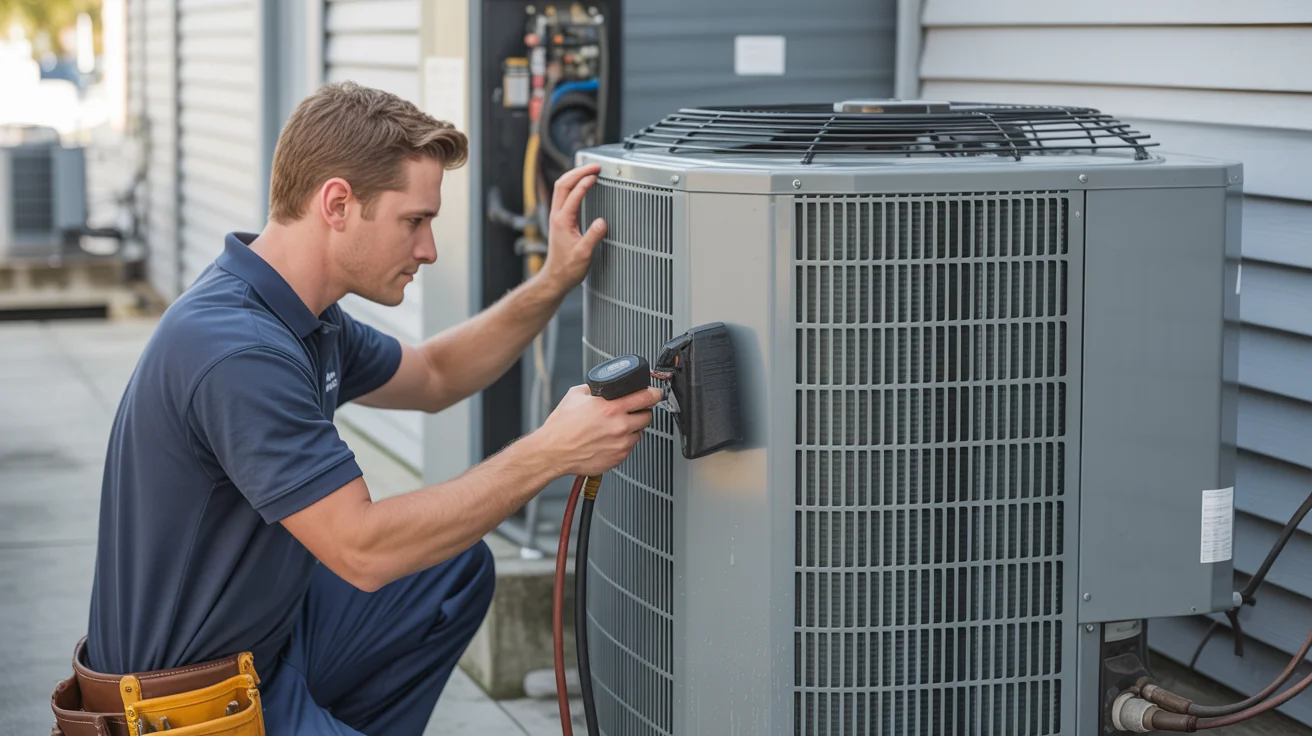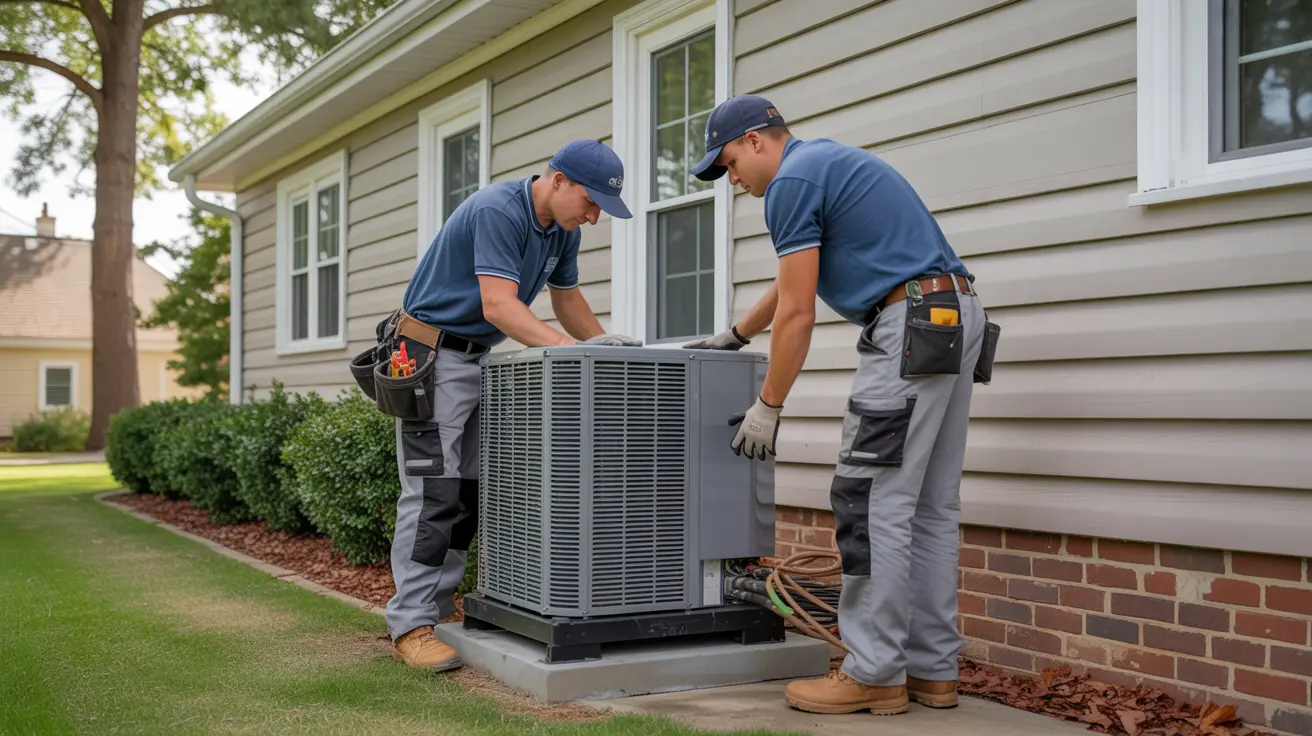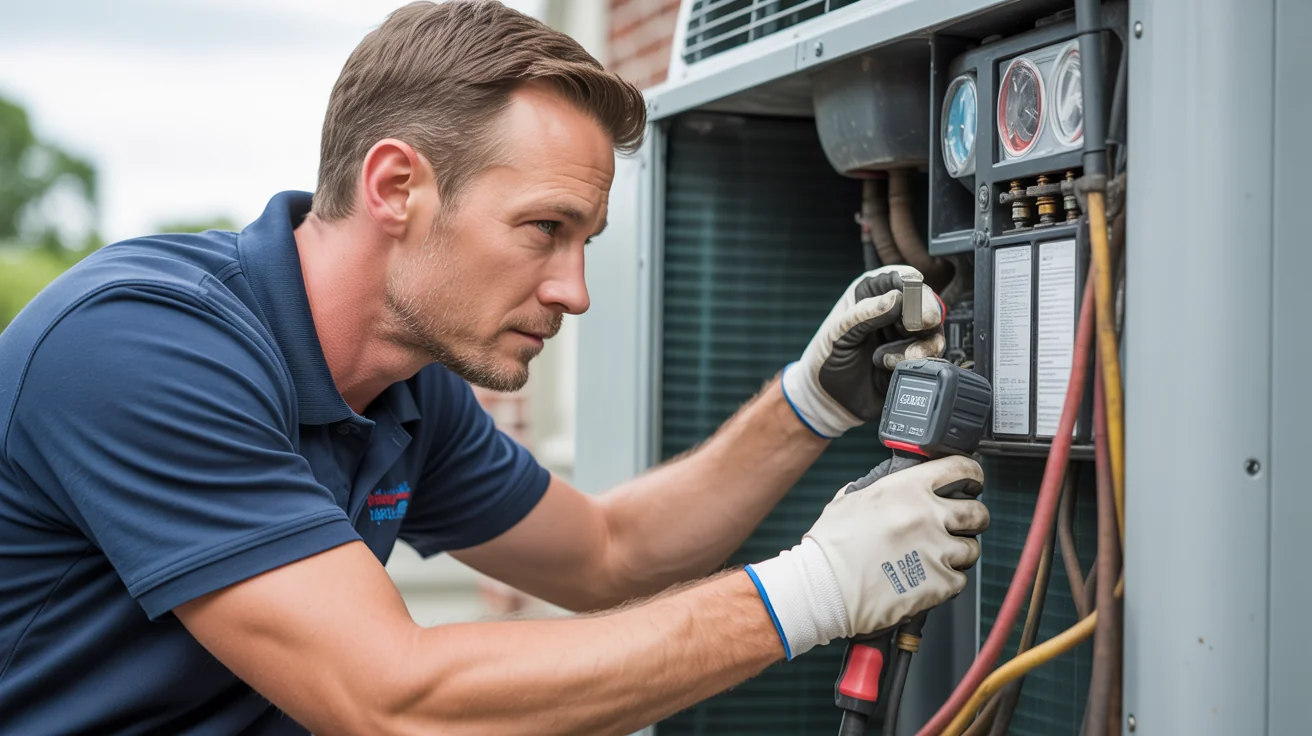Spring HVAC Maintenance for North Texas: Complete Seasonal Transition Checklist
Comprehensive spring HVAC maintenance guide for North Texas. Expert checklist for AC preparation, heating system shutdown, and seasonal optimization to make sure peak summer performance.

- The Six-Week Window That Determines Your Summer Survival
- Why “Just Wait Until It Gets Hot” is a $5,000 Mistake
- Complete Spring HVAC Maintenance Checklist
- North Texas Specific Maintenance Considerations
- Pollen and Allergen Management
- Storm Season Preparation
- Heat Preparation Strategies
- DIY vs. Professional Service Guidelines
+ 16 more sections below...
- The Six-Week Window That Determines Your Summer Survival
- Why “Just Wait Until It Gets Hot” is a $5,000 Mistake
- Complete Spring HVAC Maintenance Checklist
- North Texas Specific Maintenance Considerations
- Pollen and Allergen Management
- Storm Season Preparation
- Heat Preparation Strategies
- DIY vs. Professional Service Guidelines
+ 16 more sections below...
The Six-Week Window That Determines Your Summer Survival
Spring in North Texas lasts about six weeks if we’re lucky. Seriously. Tuesday you’re running the heater, Friday you’re cranking the AC. Blink and you’ve missed your only chance to prepare for another summer of equipment torture.
I’ve learned something painful over 15 years: families who skip spring maintenance pay for it all summer long. Poor spring prep causes 70% of the AC failures I diagnose between June and August. Systems limping along on dirty coils, loose connections, and failed components that could have been caught in March.
Meanwhile, customers who do proper spring maintenance see their cooling costs drop 15-25% because their systems are running efficiently from day one of the heat.
After thousands of spring maintenance calls, I know exactly what needs attention during this make-or-break transition period.
Why “Just Wait Until It Gets Hot” is a $5,000 Mistake
Our compressed seasons create maintenance challenges that would boggle engineers from moderate climates. Other places get gradual warming - 60s to 70s to 80s over months. We go from needing heat on Tuesday to needing maximum AC by Friday.
There’s no gentle warm-up period where minor problems reveal themselves gradually. When summer hits North Texas, everything has to work perfectly from day one. Your system doesn’t get to ease into 100-degree operation - it goes straight from hibernation to maximum abuse.
Minor problems that might be manageable elsewhere become system killers here. Storm season preparation becomes critical as spring storms can damage outdoor equipment before summer heat arrives. The allergen explosion brings massive pollen loads that clog filters and stress systems beyond normal capacity. Temperature swings create daily temperature variations of 30-40°F that stress equipment through rapid thermal cycling.
Cost of Neglecting Spring Maintenance:
Neglecting spring maintenance leads to a 300% higher likelihood of summer AC failure when you need your system most. You’ll face 25-40% increased energy costs throughout the cooling season as your inefficient system works harder to maintain comfort. Emergency service calls during peak heat periods cost significantly more than preventive maintenance, and you’ll face premature equipment replacement from preventable damage. Most critically, you risk health consequences from poor indoor air quality during extreme heat when your family depends on your HVAC system for safety.
Complete Spring HVAC Maintenance Checklist
Phase 1: System Safety and Assessment (45 minutes)
Pre-Service Safety Protocol:
- Turn off all power at main electrical panel and unit disconnects
- Shut off gas supply to heating equipment (if applicable)
- Allow system to sit for 30 minutes before beginning work
- Photograph current conditions for before/after comparison
- Test electrical safety with non-contact voltage tester
Initial System Assessment:
Begin with a comprehensive evaluation of your equipment’s overall condition and age to establish baseline expectations. Conduct a thorough winter damage inspection, looking for ice damage, storm impacts, and settling issues that may have occurred during the dormant season. Assess visible wear patterns and component condition to identify areas requiring attention. Examine ductwork integrity and insulation condition throughout accessible areas. Complete a thermostat function and calibration check to ensure accurate temperature control.
Phase 2: Heating System Shutdown and Service (60 minutes)
Furnace End-of-Season Service:
1. Complete Combustion System Inspection
- Heat exchanger visual inspection for cracks or corrosion
- Burner assembly cleaning and adjustment
- Gas valve operation verification
- Venting system integrity and clearance check
- Carbon monoxide testing around equipment
2. Blower System Service
- Blower motor lubrication (if applicable)
- Blower wheel cleaning and inspection
- Belt inspection and tension adjustment
- Motor mount inspection for looseness or wear
- Air filter housing cleaning and seal check
3. Control System Testing
- Thermostat calibration and operation verification
- Safety control testing (limit switches, pressure switches)
- Gas valve electrical testing
- Ignition system cleaning and testing
- Flame sensor cleaning and resistance testing
Heat Pump End-of-Season Service:
1. Outdoor Unit Comprehensive Service
- Coil cleaning and straightening
- Fan motor lubrication and testing
- Refrigerant level verification
- Electrical connection inspection and tightening
- Defrost system testing and calibration
2. Indoor Unit Service
- Auxiliary heat element testing
- Indoor coil inspection and cleaning
- Refrigerant line insulation inspection
- Condensate system cleaning and testing
- Air handler motor service and testing
Phase 3: Air Conditioning Preparation and Startup (90-120 minutes)
Central AC System Preparation:
1. Outdoor Unit Preparation
- Remove all winter covers and debris
- Clean condenser coil thoroughly with appropriate cleaner
- Straighten bent coil fins with fin comb
- Check and tighten all electrical connections
- Lubricate fan motor bearings (if serviceable)
- Inspect fan blade condition and balance
- Check refrigerant lines for damage or insulation issues
2. Indoor Unit Service
- Replace air filter with appropriate MERV rating for North Texas conditions
- Clean evaporator coil if accessible
- Check condensate drain and pan for clogs or damage
- Inspect ductwork connections for separation or leaks
- Test blower motor operation at all speeds
- Verify proper airflow at all supply vents
3. Refrigerant System Testing
- Measure refrigerant levels with proper gauges
- Test system pressures under operating conditions
- Check for refrigerant leaks using electronic detector
- Verify proper superheat and subcooling values
- Test expansion valve or orifice operation
- Document baseline performance measurements
4. Electrical System Verification
- Check voltage and amperage at all major components
- Test capacitor values and condition
- Inspect contactors and relays for wear or burning
- Verify proper grounding throughout system
- Test low-voltage control circuits
- Check thermostat wire connections and operation
Phase 4: Ductwork and Indoor Air Quality Assessment (45-60 minutes)
Ductwork Inspection and Service:
1. Visual Ductwork Assessment
- Check all visible ductwork for separation or damage
- Inspect ductwork insulation for completeness and condition
- Verify proper duct support and hanging systems
- Check for pest infiltration or nesting
- Measure temperature differences across major duct runs
2. Airflow Testing and Balancing
- Measure airflow at each supply register
- Check static pressure in main supply and return ducts
- Verify proper return air pathways throughout home
- Test and adjust dampers for optimal flow distribution
- Check for undersized ductwork or restriction points
Indoor Air Quality Optimization:
1. Filtration System Enhancement
- Upgrade to higher-efficiency filters appropriate for North Texas allergens
- Check filter housing for bypass leaks
- Consider whole-home air purification system installation
- Inspect and service existing air quality equipment
2. Humidity Control Assessment
- Test current humidity levels throughout home
- Inspect existing humidification/dehumidification equipment
- Assess need for whole-home humidity control
- Check vapor barriers and moisture intrusion points
Phase 5: System Testing and Performance Verification (60 minutes)
Comprehensive Performance Testing:
1. Cooling System Performance Test
- Start system and monitor startup sequence
- Verify proper refrigerant pressures and temperatures
- Test cooling capacity at outdoor design conditions
- Measure temperature differential across indoor coil
- Check amp draw of all major electrical components
- Verify proper cycling and thermostat response
2. Heating System Performance Verification (for final season-end testing)
- Test heating system operation for proper shutdown
- Verify all safety controls function properly
- Check for proper heat exchanger operation
- Test thermostat changeover operation
- Document final heating season performance data
3. Overall System Integration Testing
- Test automatic changeover between heating and cooling modes
- Verify proper fan operation in all modes
- Check emergency heat operation (heat pump systems)
- Test all thermostat functions and programming
- Verify proper system response to outdoor temperature changes
North Texas Specific Maintenance Considerations
Pollen and Allergen Management
The North Texas Pollen Challenge: Spring pollen counts in North Texas regularly exceed 9,000 particles per cubic meter—among the highest in the nation.
Specialized Filtration Strategy:
- Install high-efficiency pleated filters (MERV 11-13) before pollen season peak
- Change filters every 2-3 weeks during peak pollen season (March-May)
- Consider washable pre-filters for outdoor unit protection
- Seal all filter housing bypass gaps to prevent pollen infiltration
Coil Protection During Pollen Season:
- Apply protective coil coating to outdoor unit before season
- Schedule mid-season coil cleaning during peak pollen periods
- Install coil guards or screens to reduce direct pollen exposure
- Monitor system performance weekly during heavy pollen periods
Storm Season Preparation
Severe Weather System Protection:
1. Physical Protection Measures
- Secure loose outdoor unit components and panels
- Clear area around outdoor unit of potential projectiles
- Install protective barriers against hail damage (where appropriate)
- Check and reinforce outdoor unit mounting and levelness
2. Electrical Protection Systems
- Install whole-home surge protection for HVAC equipment
- Check grounding systems for corrosion or damage
- Verify proper GFCI protection where required
- Consider backup power options for critical system operation
Heat Preparation Strategies
Preparing for Extreme Summer Heat:
1. Capacity and Efficiency Optimization
- Verify system capacity matches cooling load needs
- Optimize refrigerant charge for peak efficiency
- Ensure adequate airflow for extreme temperature operation
- Check system staging for multi-stage equipment
2. Reliability Enhancement
- Replace aging components before peak season stress
- Install backup or redundant systems where feasible
- Create emergency cooling plans for system failures
- Schedule preventive maintenance during moderate weather
DIY vs. Professional Service Guidelines
Homeowner-Safe Spring Maintenance Tasks
Recommended DIY Tasks:
- Air filter inspection and replacement
- Outdoor unit cleaning and debris removal
- Basic visual inspection of accessible components
- Thermostat battery replacement and basic programming
- Register and vent cleaning and adjustment
Required Safety Precautions:
- Always turn off power before any maintenance work
- Never work on gas appliances without proper training
- Use appropriate personal protective equipment
- Know when to stop and call professionals
Professional Service Requirements
Tasks Requiring Professional Service:
- Refrigerant system testing and service
- Electrical system testing and repairs
- Gas appliance inspection and service
- Ductwork modifications and major repairs
- System performance testing and optimization
Professional Service Value:
Professional service provides EPA-certified technicians qualified for refrigerant work and specialized test equipment for accurate diagnosis. You receive warranty protection for service work performed and safety compliance for gas and electrical systems. Professional service includes performance guarantees and callback protection, ensuring your investment delivers the expected results.
Regional Service Timing and Scheduling
Optimal Service Timing for North Texas
Recommended Service Schedule:
Early March:
- Initial system assessment and planning
- Schedule professional service appointments
- Order replacement parts and filters
- Begin outdoor unit preparation
Mid-March:
- Complete heating system end-of-season service
- Begin AC system preparation and startup
- Perform complete system testing
- Address any identified problems or deficiencies
Late March/Early April:
- Final system optimization and tuning
- Complete performance verification testing
- Implement allergen management strategies
- Finalize emergency service plans
City-Specific Timing Considerations
Dallas-Fort Worth Metro:
- Earlier service scheduling due to urban heat island effects
- Focus on air quality management for higher pollution levels
- Consider peak demand management for electrical grid stability
- Coordinate with newer home warranty needs
- Optimize smart home system integration
- Schedule around neighborhood service demand
McKinney, Prosper, The Colony:
- Allow for rural service scheduling challenges
- Consider backup power options for remote areas
- Address varying home age and system complexity
Cost Analysis and Investment Planning
Spring Maintenance Investment Breakdown
Professional Comprehensive Spring Service: $199-399
Comprehensive spring service includes complete heating system end-of-season service and full AC system preparation and startup. The service covers performance testing and optimization, safety inspection and compliance verification, plus a written performance report with specific recommendations for your system.
Potential Value and Savings:
Avoided summer emergency service saves $400-1,200 per incident through proper preparation and maintenance. Energy efficiency improvement provides $300-800 per cooling season through optimized system performance. Extended equipment life offers $500-1,500 annual value through proper care and maintenance. Improved comfort and reliability provides invaluable benefits during extreme heat when systems are most critical.
Return on Investment: 400-800% through avoided emergency costs and improved efficiency
Optional Enhancement Investments
High-Impact Upgrades During Spring Service:
1. Smart Thermostat Installation ($200-500)
- Advanced programming for North Texas conditions
- Peak demand management capabilities
- Remote monitoring and control features
- Integration with home automation systems
2. Air Quality System Addition ($800-2,500)
- Whole-home air purifier installation
- UV light system for coil treatment
- Advanced filtration system upgrade
- Humidity control system integration
3. System Efficiency Improvements ($500-2,000)
- Variable speed motor upgrade
- Duct sealing and insulation enhancement
- Coil coating for protection and efficiency
- Zoning system installation for targeted comfort
Maintenance Plan Benefits and Programs
Annual Maintenance Plan Advantages
Comprehensive Maintenance Plan Benefits:
Annual maintenance plans provide priority scheduling for critical spring and fall service appointments. You receive discounted rates on additional services and repairs throughout the year, plus extended warranty coverage on serviced equipment. Plans include emergency service priority during peak seasons when service demand is highest. Professional maintenance includes performance monitoring and trend analysis to catch problems before they become expensive failures.
Typical Plan Includes:
- Two annual service visits (spring preparation, fall heating prep)
- All routine maintenance tasks and adjustments
- Filter delivery service (optional)
- Performance guarantees and satisfaction warranties
- 24/7 emergency service priority
Customer Satisfaction Guarantees
Service Quality Assurance:
Our service includes written performance guarantees on all service work and customer satisfaction warranties with callback service. All replaced components come with parts and labor warranties, and we provide performance improvement guarantees or service credit if expectations aren’t met. Throughout the service process, you’ll receive clear communication and education about your system’s condition and recommendations.
Emergency Preparedness and Backup Plans
Summer System Failure Preparation
Emergency Action Plan:
-
Immediate Response Protocol
- System failure assessment and safety verification
- Emergency cooling alternatives (fans, temporary units)
- Priority service scheduling and communication
- Family safety and health protection measures
-
Backup Cooling Options
- Portable AC units for critical areas
- Window unit installation in bedrooms
- Public cooling center locations and hours
- Hotel accommodation planning for extreme situations
-
Service Provider Communication
- Emergency contact information readily available
- Service history and equipment information organized
- Clear communication of priority areas and special needs
- Understanding of service timelines and expectations
Frequently Asked Questions
Q: When should I schedule spring HVAC maintenance in North Texas? A: Schedule service in early to mid-March before peak pollen season and before cooling demands begin. Early scheduling make sures availability and allows time for any needed repairs.
Q: How often should I change my air filter during spring? A: During peak pollen season (March-May), check filters every 2 weeks and replace every 2-4 weeks depending on conditions. High pollen days may require more frequent changes.
Q: Should I run my AC during mild spring weather? A: Yes, run your AC periodically during mild weather to check proper operation and spot any problems before peak cooling season begins.
Q: What should I do if my AC isn’t cooling properly during the first use? A: Turn off the system immediately and call for professional service. Do not attempt repairs on refrigerant or electrical systems. Early season problems often indicate winter damage or maintenance needs.
Q: How can I prepare for the high cooling costs of summer? A: Spring maintenance, efficiency optimization, programmable thermostat installation, and peak demand management strategies can reduce cooling costs by 15-30%.
Q: Is spring maintenance really necessary if my system worked fine last summer? A: Yes, winter weather, spring storms, pollen exposure, and system aging require annual maintenance to make sure reliable summer operation and efficiency.
Take Action: Schedule Your Spring HVAC Maintenance
Don’t gamble with your family’s comfort during the brutal North Texas summer. Professional spring maintenance make sures your system is ready for months of extreme heat and humidity.
Ready to prepare your HVAC system for summer?
Call (940) 390-5676 for complete spring maintenance service. Schedule online at jupitairhvac.com/contact. Ask about our annual maintenance plans for priority service. Get started with early season scheduling for best availability.
Complete Service Coverage Areas
Jupitair HVAC provides complete spring maintenance throughout North Texas:
Frisco and Plano offer priority service scheduling for spring maintenance. McKinney, Allen, and The Colony receive full service coverage with experienced technicians. Prosper, Little Elm, and Addison enjoy both residential and commercial service options. We serve all surrounding communities within our service area.
Proper spring HVAC maintenance is essential for surviving North Texas summer heat. Trust Jupitair HVAC’s expertise to prepare your system for reliable, efficient operation through the most demanding conditions.
Jupitair HVAC - Your North Texas HVAC maintenance specialists since 2008. Licensed & Insured.
Need Professional HVAC Service?
Our certified technicians are ready to help with any HVAC needs in North Texas




